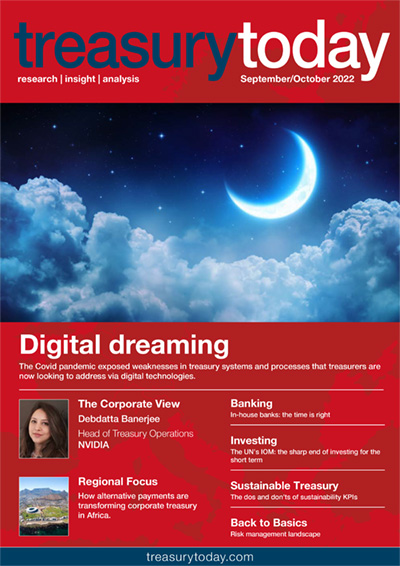Contents
- Editorial
- Time to prepare
- Insight & Analysis
- Digital dreaming
- Investing
- The UN’s IOM reveals the sharp end of investing for the short term
- Smarter Treasury: BlackRock
- Money market fund technology in a rising rate environment
- Banking
- All in the house
- The Corporate View
- Corporate View: Debdatta Banerjee, NVIDIA
- Sustainability
- Treasury gets to grips with sustainability KPIs
- Smarter Treasury: J.P. Morgan
- The sweeping digitisation trends promising treasury transformation ahead
- Regional Focus
- Payments evolution leads steady transformation of African treasury
- Back to Basics
- Navigating the new risk landscape
- Question Answered
- Question Answered: Preparing for recession
- Market View
- Interest rates: hikes into next year, then central banks will change course
Editorial
Time to prepare
As this edition goes to press, the UK is absorbing the loss of HM Queen Elizabeth II, the country’s longest standing monarch. A force of stability and resilience for 70 years, the person the country has looked to in times of crisis is no longer there and her passing accentuates a sense of change against the backdrop of already profound economic challenges.
Times are challenging for governments the world over, but the UK’s new prime minster, Liz Truss faces a particularly onerous in tray. The slowing economy is poised to enter recession; inflation is at its highest rate in decades, the pound is nearing near record lows and energy prices are crippling.
In this edition’s Question Answered, we ask treasury experts how to prepare for recession: regular, rolling, integrated forecasting is the emphatic response. The process will reveal cash and liquidity levels, and flag if treasury is getting close to committed facilities. It involves talking to sales, account receivables and payroll and finding out what is coming in, and what is going out.
In another, timely article, this edition also goes back to basics on hedging, offering insights on how companies can adjust their hedging strategies to the current landscape.
Sustainability
As banks increasingly shift their loan books to companies on a transition path, we explore treasury’s role when it comes to choosing sustainable KPIs, the targets that link the cost of corporate borrowing to sustainable achievement. We hear how many corporates feel trapped in a transparency paradox; the more they disclose, the more stones are potentially thrown, yet peers that don’t disclose or set ambitious KPIs may not be subject to the same scrutiny.
Other features explore key digitisation trends as automation and technology drive corporate behaviour beyond a simple move online. Continuing the theme, this edition travels to Africa where digital payments are transforming the continent’s fragmented and complex payment and banking infrastructure. The use of APIs and open banking are gathering pace and requests to digitise receivables is one of the most frequent RFPs.
Lastly, Malcolm Grant, Chief of Treasury at the UN’s International Organization for Migration shares his insight on how to invest millions of dollars in a short-term window. A play-it-safe strategy used to focus on bank deposits until the GFC proved that level of exposure to the financial sector risky. Today, around 80% of the portfolio lies in short-term placements, between 5-10% is in MMFs and the remainder (around 5%) is in a dual currency allocation.


